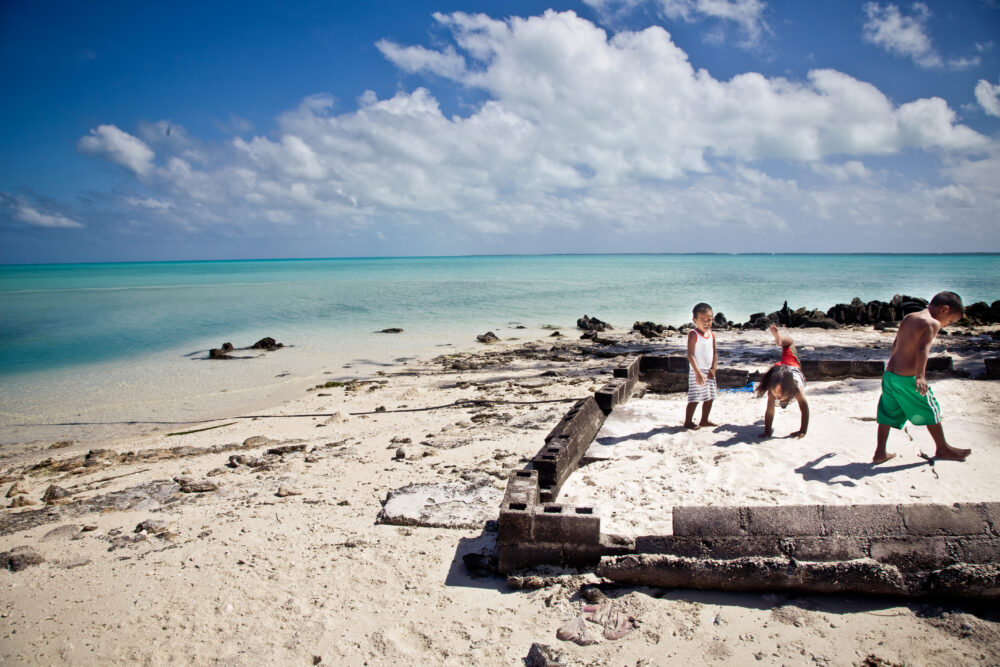By Professor Jane McAdam, Director of the Kaldor Centre for International Refugee Law at UNSW Sydney, and member of the PDD Advisory Committee. Article first published in The Sydney Morning Herald – 20 January 2020 | Photo credit: Benoit Matsha-Carpentier / IFRC, Kiribati, 2013
In a landmark decision, the UN Human Rights Committee has found it is unlawful for governments to send people back to countries where climate change impacts expose people to life-threatening risks or cruel, inhuman or degrading treatment. It has taken 25 years of case law to get to this point.
The case concerns Ioane Teitiota from Kiribati, a small island nation in the Pacific. He said the effects of climate change and sea-level rise forced him to move to New Zealand: life at home was increasingly precarious as a result of overcrowding, erosion, inundation and insufficient fresh water. Claiming to be the world’s first “climate change refugee”, he received global attention in 2015 when New Zealand rejected his application for protection. He then argued before the UN Human Rights Committee that by deporting him, New Zealand had violated his right to life.
The committee upheld the reasoning of the New Zealand immigration tribunal and the courts, which was that in his particular case, it was safe for him to return to Kiribati. The situation there was not yet so dire that Teitiota and his family faced an imminent risk to their lives.
Significantly, though, the committee found that “without robust national and international efforts”, the effects of climate change may expose people to life-threatening risks or cruel, inhuman or degrading treatment, “thereby triggering the non-refoulement obligations of sending states”. In other words, countries would be prohibited from sending people back to these conditions, in the same way it is unlawful for them to return refugees to persecution.
The committee said people at risk should not have to wait until their lives were imminently threatened: they should receive protection earlier. As one committee member said, it would “be counterintuitive to the protection of life, to wait for deaths to be very frequent and considerable” to consider the threshold of risk had been met.
However, the committee did not provide much guidance as to where the tipping point lay. It endorsed the New Zealand tribunal and courts’ reasoning that risks materialising 10 to 15 years into the future would be too speculative to give rise to protection now, since this timeframe could allow Kiribati, assisted by the international community, “to take affirmative measures to protect and, where necessary, relocate its population”.
Significantly, it said each new case would have to be considered on its merits, taking into account “the situation at the time in … Kiribati and new and updated data on the effects of climate change and rising sea-levels thereupon”.
A first for UN
This is the first time the UN Human Rights Committee has expressly acknowledged that human rights law prohibits governments from sending people to places where they face a real risk of life-threatening or serious harm from the adverse impacts of climate change. The decision is not legally binding but the international legal obligations on which it is based are.
The challenge now lies in implementation. Governments must ensure national laws enable people to claim – and receive – protection from the adverse effects of climate change. In this respect, the evidence-based recommendations of intergovernmental initiatives such as the Nansen Initiative’s Protection Agenda and the Platform on Disaster Displacement provide a blueprint of good practices from around the world. These include creating visas and migration pathways that enable people to get out of harm’s way before disaster strikes, and ensuring that people who are displaced receive protection, including a legal status that safeguards their human rights.
Government obligation
These recommendations are echoed in the Global Compact on Safe, Orderly and Regular Migration, endorsed by most of the world’s governments in December 2018. The compact reaffirms that governments have an obligation to not return people to situations of irreparable harm. It urges governments to create more flexible migration programs to help people at risk of displacement from climate change, disasters and environmental degradation.
As the world watches Australia’s unprecedented bushfires destroy land the size of South Korea and displace many thousands of people in the process, the devastation wreaked by disasters in the era of climate change is all too real. At a time when more people are displaced by disasters than by conflict, the imperative to devise protection and migration policies is clear. The blueprints are already there; our leaders just need to find the political will to implement them.
Learn more about the Kaldor Centre for International Refugee Law
Learn more about the PDD Advisory Commitee





